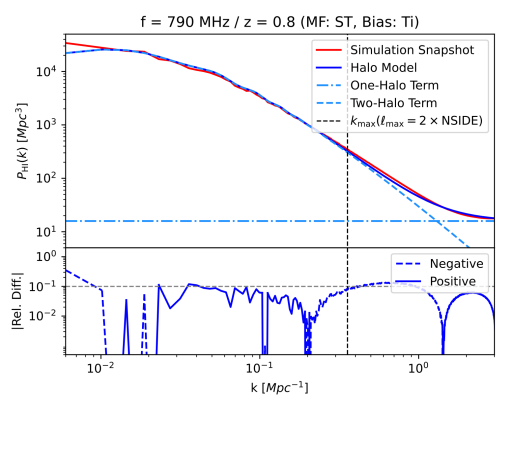Cosmological Neutral Hydrogen Simulation
We present the data products from our fast, large-volume simulation pipeline for cosmological neutral hydrogen (HI), as described in external page Hitz et al. (2024). This simulation is specifically designed for 21 cm intensity mapping studies in the post-reionization era. Our approach employs the fast external page PINOCCHIO code to generate the past light cone of dark matter halos, to which HI is subsequently assigned based on an HI-halo mass relation calibrated on observations.
We provide a simulation optimized for the application to the Hydrogen Intensity and Real-time Analysis eXperiment (HIRAX), a radio interferometer array under construction in South Africa. This means a past light cone for declinations between -15° and -35° in the frequency range from 700 to 800 MHz, which corresponds to a redshift range from 0.77 to 1.03, is simulated. We run PINOCCHIO for a (1 Gpc/h)3 box, resulting in 40 replications to cover the light cone volume. The resulting light cone is then divided into 20 equally spaced frequency channels with a width of 5 MHz to produce dark matter and HI brightness temperature external page HEALPix maps.

Data Download
The full dataset is hosted at ETH Zurich and accessible via the external page Globus service. After logging in, the data can be found in the external page CosmoHI collection. For any inquiries, please contact Pascal Hitz.
We provide the parameter file used to run PINOCCHIO, along with a tar-archive containing the specific PINOCCHIO branch, including all modifications made for execution.
The ./snapshots directory contains the dark matter halo catalogues from a single simulation box at redshifts 0.8, 0.9 and 1. Each snapshot is divided into 96 files (e.g. pinocchio.0.8000.run.catalog.out.0). Additionally, we provide the corresponding PINOCCHIO mass functions for each redshift (e.g. pinocchio.0.8000.run.mf.out).
The ./lightcone directory contains the past light cone, stored in 96 files (e.g. pinocchio.run.plc.out.0).
The ./skymaps directory contains the dark matter and HI brightness temperature HEALPix maps, saved as HDF5 files. These maps were generated with an NSIDE of 512. For completeness, we also provide HI mass maps and halo count maps. The figure below illustrates the structure of the HDF5 files. The 'index_map' group stores the frequency bins (defined by their centre and width), redshift bins (with upper and lower limit), pixel numbering and polarisations. Since the file format must comply with the HIRAX pipeline requirements, all four polarisations are included in the HI brightness temperature maps. However, as we only simulate the intensity ('I'), the pixel values for the polarised maps ('Q', 'U' and 'V') are set to zero. No polarised maps are stored for dark matter, HI mass and halo count maps. The 'map' group contains the pixel values of the maps. Temperature maps are in units of Kelvin, mass maps in solar masses and halo count maps in number of halos per pixel.

Publications
A detailed description of the simulation framework is presented in external page Hitz et al. (2024). As part of this work, the simulations have been validated against an analytical dark matter and HI halo model implemented in PyCosmo, a Python package for theoretical cosmological predictions.
If you use the data provided here in your publications, please cite the above paper.
Comparison between simulation and analytical halo model


